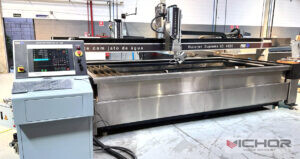
What Are the 7 Key Aspects of Waterjet Cutting Granite for Your Projects?
When it comes to cutting hard materials like granite, precision and efficiency are paramount. Waterjet cutting granite has emerged as a popular method in various industries, from construction to art, due to its unique capabilities. But what exactly makes this technique stand out? In this article, we delve into seven essential aspects of waterjet cutting granite, providing you with a comprehensive understanding of how it works, its benefits, limitations, and more. Whether you’re a contractor, designer, or DIY enthusiast, this information will help you determine if waterjet cutting granite is the right choice for your needs. By the end, you’ll have a clear picture of why this method is gaining traction and how it can be applied effectively.
What Is Waterjet Cutting Granite?
Waterjet cutting granite is a process that uses a high-pressure stream of water, often mixed with abrasive materials, to cut through granite slabs with precision. This method is known for its versatility and ability to handle complex designs without compromising the integrity of the stone. Granite, being a hard and durable natural stone, requires a cutting technique that can avoid cracks, chips, or thermal damage. Waterjet cutting granite achieves this by relying on mechanical erosion rather than heat, making it ideal for intricate patterns, curves, and detailed work. The process involves directing a focused jet of water at speeds exceeding Mach 3, which, when combined with abrasives like garnet, can slice through granite effortlessly. This introduction to waterjet cutting granite sets the stage for understanding its broader applications and advantages in modern fabrication.
How Does the Waterjet Cutting Process Work for Granite?
The waterjet cutting process for granite begins with a high-pressure pump that pressurizes water to levels around 60,000 to 90,000 psi. This pressurized water is then forced through a small nozzle, creating a narrow stream that moves at incredible speeds. For cutting hard materials like granite, an abrasive substance—typically garnet—is introduced into the stream to enhance cutting power. The mixture of water and abrasive erodes the granite surface along a pre-programmed path, guided by computer numerical control (CNC) systems for accuracy. This allows waterjet cutting granite to produce clean edges and precise shapes, whether for countertops, tiles, or artistic installations. One key advantage is the absence of heat-affected zones, which means the granite retains its natural strength and appearance. Additionally, the process minimizes waste by optimizing material usage, making waterjet cutting granite an efficient option for both small-scale and large projects.
What Are the Advantages of Using Waterjet Cutting for Granite?
Waterjet cutting granite offers numerous benefits that make it a preferred method in many scenarios. First, it provides exceptional precision, enabling intricate designs and tight tolerances that other methods might struggle with. This is particularly useful for custom projects where detail is critical. Second, since no heat is involved, waterjet cutting granite prevents thermal damage, such as cracking or discoloration, which can occur with laser or plasma cutting. Third, it is an environmentally friendly option, as it uses water and natural abrasives, reducing harmful emissions and waste. Fourth, waterjet cutting granite is highly versatile, capable of handling various thicknesses and types of granite without the need for tool changes. Fifth, it reduces material waste through efficient nesting and cutting paths, saving costs in the long run. Overall, these advantages make waterjet cutting granite a reliable and sustainable choice for professionals.
What Are the Limitations of Waterjet Cutting Granite?
Despite its many benefits, waterjet cutting granite does have some limitations. One primary concern is the cost: the equipment and maintenance for waterjet systems can be expensive, especially for small businesses or hobbyists. Additionally, the cutting speed for waterjet cutting granite might be slower compared to methods like saw cutting, which could impact project timelines for high-volume jobs. Another drawback is the potential for surface abrasion or “stray cutting” if not properly calibrated, leading to minor imperfections. Waterjet cutting granite also requires a steady supply of water and abrasives, which can add to operational costs and environmental considerations if not managed responsibly. Lastly, the process can generate noise and slurry waste, necessitating proper disposal methods. Understanding these limitations helps in planning and mitigating risks when opting for waterjet cutting granite.

Where Is Waterjet Cutting Granite Commonly Applied?
Waterjet cutting granite finds applications across a wide range of industries due to its precision and flexibility. In the construction sector, it is used for creating custom countertops, flooring tiles, and architectural elements with intricate patterns. The monument and memorial industry relies on waterjet cutting granite for detailed engravings and shapes that honor historical events or individuals. In interior design, this method enables the production of unique backsplashes, furniture pieces, and decorative items from granite. Art and sculpture projects also benefit from waterjet cutting granite, as artists can achieve complex forms without compromising the stone’s natural beauty. Moreover, industrial applications include manufacturing parts for machinery or fixtures where granite’s durability is essential. The versatility of waterjet cutting granite ensures it meets diverse needs, from functional to aesthetic.
How Does Waterjet Cutting Compare to Other Granite Cutting Methods?
When comparing waterjet cutting granite to other methods like diamond saw cutting, laser cutting, or wire sawing, several distinctions arise. Waterjet cutting granite excels in precision and versatility, allowing for complex shapes without heat damage, whereas laser cutting can generate heat that may weaken granite. Diamond saw cutting is faster for straight cuts but struggles with curves and details, making waterjet cutting granite superior for intricate work. Wire sawing is effective for large-scale quarrying but lacks the finesse needed for fine designs. In terms of environmental impact, waterjet cutting granite uses water and abrasives, which are generally safer than the dust and debris produced by sawing methods. However, waterjet cutting might be slower and more costly than some alternatives. This comparison highlights why waterjet cutting granite is often chosen for projects demanding high accuracy and minimal material compromise.
What Should You Consider Before Choosing Waterjet Cutting for Granite?
Before deciding on waterjet cutting granite for your project, consider factors such as cost, project scope, and desired outcomes. Evaluate your budget for equipment or service fees, as waterjet cutting granite can be more expensive upfront but may save money through reduced waste and rework. Assess the complexity of your design—if it involves detailed patterns or curves, waterjet cutting granite is likely the best fit. Also, think about material thickness; this method handles various thicknesses well, but extremely thick granite might require adjustments. Environmental regulations and waste management for water and abrasives should be reviewed to ensure compliance. Lastly, consult with professionals to determine the feasibility and timeline for waterjet cutting granite in your specific context. By weighing these considerations, you can make an informed decision that aligns with your goals.
In summary, waterjet cutting granite is a highly effective method that combines precision, versatility, and environmental benefits. From its working mechanism to practical applications, understanding these seven aspects can help you leverage this technology for better results. As industries continue to evolve, waterjet cutting granite remains a valuable tool for achieving quality and innovation in granite fabrication.
Frequently Asked Questions (FAQ)
Q1: What is the typical cost range for waterjet cutting granite projects?
A1: The cost of waterjet cutting granite can vary widely based on factors like project size, complexity, and material thickness. On average, it might range from $50 to $150 per hour for machine time, plus additional expenses for abrasives and setup. For custom pieces, prices could be higher, but waterjet cutting granite often reduces waste, potentially offsetting costs in the long term.
Q2: How thick can granite be cut using waterjet technology?
A2: Waterjet cutting granite can handle thicknesses up to 12 inches or more, depending on the equipment and abrasive mix. However, thicker slabs may require slower cutting speeds to maintain precision and edge quality. It’s best to consult with a service provider to assess specific capabilities for your project.
Q3: Is waterjet cutting granite safe for the environment?
A3: Waterjet cutting granite is generally considered environmentally friendly compared to methods that produce dust or use chemicals, as it primarily uses water and natural abrasives. However, proper disposal of wastewater and slurry is essential to prevent contamination. Many systems incorporate recycling features to minimize environmental impact.
Q4: Can waterjet cutting be used for other stones besides granite?
A4: Yes, waterjet cutting is versatile and can be applied to various materials, including marble, quartz, tile, and even metals. The process adapts well to different hardness levels, making waterjet cutting granite part of a broader range of applications in stone fabrication.
Q5: What maintenance is required for waterjet cutting equipment used on granite?
A5: Regular maintenance for waterjet cutting granite equipment includes inspecting nozzles and pumps for wear, replacing abrasives, and cleaning filters to ensure optimal performance. Proper upkeep helps prevent downtime and maintains the precision needed for high-quality cuts in granite projects.
continue reading
Related Posts
- 1821 words9.2 min read
- 1691 words8.5 min read



